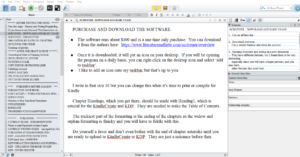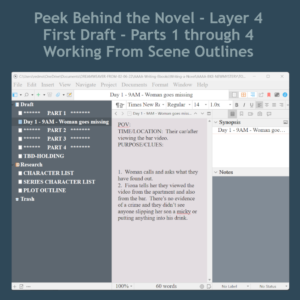The Need to Establish Where You Are:
MYSTERY NOVEL SCENE IMPROVEMENT CHECKLIST
 This is a checklist I wish I had when I first started out as an author. With the internet and research being at our fingertips, anyone can figure out how to write a first draft. In the world I live in, a first draft is nothing more than blurting out the story onto paper so you have something to begin working on.
This is a checklist I wish I had when I first started out as an author. With the internet and research being at our fingertips, anyone can figure out how to write a first draft. In the world I live in, a first draft is nothing more than blurting out the story onto paper so you have something to begin working on.
When writing the first draft, you don't even have on your author's hat yet. You are only a mapmaker really. You are putting down the basic storyline that can be massaged into a real story and ultimately into a real novel.
In my opinion, we are all limited by our capabilities as they exist in time. That means that you can only write the story to the best of your ability, based on what you presently know.
The purpose of this blogpost and checklist is to go over techniques that will allow you to expand your horizons. Let it guide your creative mind in certain areas with the intent purpose of "taking the story up a notch". These questions helped me along the way, but like I said earlier, I wish I began to ask them earlier in my author journey.
I offer them now to new authors in the hopes that this will help you take new ground as an author and improve your scenes beyond what you may be capable of at any given time.
ESTABLISH WHERE YOU ARE
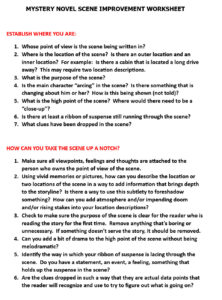 This questionnaire is meant to be applied after you have written a first draft and have gone over the draft once in order to make sure the story flows from scene to scene and from chapter to chapter.
This questionnaire is meant to be applied after you have written a first draft and have gone over the draft once in order to make sure the story flows from scene to scene and from chapter to chapter.
A Special Note to Beginners: Any attempt to "write perfectly" with these questions in mind will only slow down your draft process. I have other beginner advice in my Peek Behind the Novel series you may be interested in.
This checklist is meant to be applied to each scene individually during the massaging stage. What is the massaging stage? Each new novel begins with a draft stage, goes into an overall check for the flow of the story and then to a single focus of making sure all clues and twists are all in their proper place. Then you enter the massaging-the-story stage. This is where this checklist will be very helpful.
QUESTIONS TO ASK ABOUT EACH SCENE:
- Whose point of view is the scene being written in?
- Where is the location of the scene? Is there an outer location and an inner location? For example: Is there a cabin that is located a long drive away? This may require two location descriptions.
- What is the purpose of the scene?
- Is the main character “arcing” in the scene? Is there something that is changing about him or her? How is this being shown (not told)?
- What is the high point of the scene? Where would there need to be a “close-up”?
- Is there at least a ribbon of suspense still running through the scene?
- What clues have been dropped in the scene?
QUESTIONS FOR EACH INDIVIDUAL SCENE
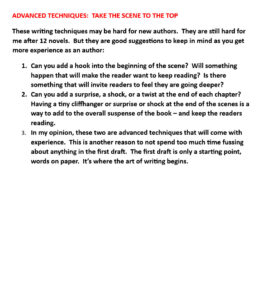 By focusing on each element individually with these questions in mind, it will allow a new author to focus on only one element at a time. It prevents new authors from becoming overwhelmed by a general suggestion to take the whole novel up a notch.
By focusing on each element individually with these questions in mind, it will allow a new author to focus on only one element at a time. It prevents new authors from becoming overwhelmed by a general suggestion to take the whole novel up a notch.
In my opinion, by focusing on each scene individually, you will erase any rushing that may have occurred in the draft process. It will give you a second chance to see if you can better describe something or foreshadow something early on in the plot.
Below are the questions that are designed to refocus a new author to how and where each scene can be improved.
HOW CAN YOU TAKE THE SCENE UP A NOTCH?
- Make sure all viewpoints, feelings and thoughts are attached to the person who owns the point of view of the scene.
- Using vivid memories or pictures, how can you describe the location or two locations of the scene in a way to add information that brings depth to the storyline? Is there a way to use this subtlety to foreshadow something? How can you add atmosphere and/or impending doom and/or rising stakes into your location descriptions?
- Check to make sure the purpose of the scene is clear for the reader who is reading the story for the first time. Remove anything that’s boring or unnecessary. If something doesn’t serve the story, it should be removed.
- Can you add a bit of drama to the high point of the scene without being melodramatic?
- Identify the way in which your ribbon of suspense is lacing through the scene. Do you have a statement, an event, a feeling, something that holds up the suspense in the scene?
- Are the clues dropped in such a way that they are actual data points that the reader will recognize and use to try to figure out what is going on?
ADVANCED TECHNIQUES
ADVANCED TECHNIQUES: TAKE THE SCENE TO THE TOP
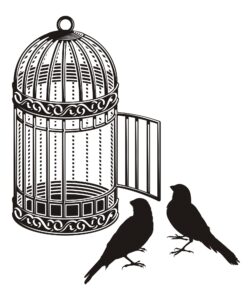
The following writing techniques may be hard for new authors. They are still hard for me after 12 novels. But they are good suggestions to keep in mind as you get more experience as an author.
These questions can be used over and over and you will see your writing take new ground with each scene as you push yourself to one tiny improvement at a time.
- Can you add a hook into the beginning of the scene? Will something happen that will make the reader want to keep reading? Is there something that will invite readers to feel they are going deeper?
- Can you add a surprise, a shock, or a twist at the end of each chapter? Having a tiny cliffhanger or surprise or shock at the end of the scenes is a way to add to the overall suspense of the book – and keep the readers reading.
- Can you add a motif of some kind? For example: In the Harry Potter books, Good vs. Evil was a classic motif that ran throughout the story. The red rose in The Great Gatsby signifies Gatsby's love and longing for Daisy.
- In my opinion, these two are advanced techniques that will come with experience. This is another reason to not spend too much time fussing about anything in the first draft. The first draft is only a starting point, words on paper. It’s where the art of writing begins.

